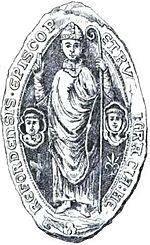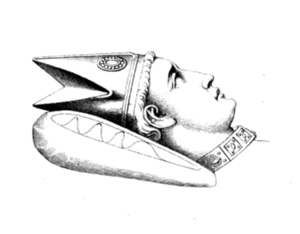Peter of Aigueblanche facts for kids
Quick facts for kids Peter of Aigueblanche |
|
|---|---|
| Bishop of Hereford | |
 |
|
| Elected | 24 August 1240 |
| Enthroned | after Christmas 1240 |
| Reign ended | 27 November 1268 |
| Predecessor | Michael |
| Successor | John de Breton |
| Other posts | Archdeacon of Shropshire |
| Orders | |
| Consecration | 23 December 1240 by Walter de Gray, Archbishop of York |
| Personal details | |
| Born | Aigueblanche |
| Died | 27 November 1268 |
| Buried | Hereford Cathedral |
| Denomination | Catholic |
Peter of Aigueblanche (also known as Peter of Aquablanca) was an important church leader in medieval England. He served as the Bishop of Hereford. Peter came to England from Savoy with Eleanor of Provence, who was marrying King Henry III of England.
He worked for the king and became a bishop in 1241. Peter was also a diplomat, helping to arrange a marriage for Prince Edward. He became involved in King Henry's plan to take over the kingdom of Sicily. Peter's efforts to raise money for this plan made many people, including church leaders and nobles, very angry.
When nobles started to rebel against King Henry, Peter was attacked. His lands and belongings were stolen. He was even arrested for a short time in 1263. After a big battle, the Battle of Evesham, he got most of his lands back. Peter died on November 27, 1268.
Contents
Becoming a Bishop: Peter's Early Life
Peter was a nobleman from a region called Savoy. He arrived in England in 1236. He worked for William of Savoy, who was a bishop. William was bringing his niece, Eleanor of Provence, to England. Eleanor was going to marry King Henry III of England. Peter might have been William's treasurer, managing his money. We don't know much else about his early life or schooling.
By 1239, Peter was working for King Henry. He received a church position in Lancashire. On August 2, 1240, the king also made him an archdeacon of Shropshire. An archdeacon is a senior church official.
Just a few weeks later, on August 24, 1240, Peter was chosen to be the Bishop of Hereford. He was officially made a bishop on December 23, 1240, in London. The ceremony was led by the Archbishop of York, Walter de Gray. Peter took his place as bishop in Hereford shortly after Christmas. The king tried to move him to a richer bishopric, Durham, but it didn't work out.
Working for the King: Royal Service
Peter continued to receive gifts from the king. These included rights to hold markets and to take wood from royal forests. In August 1241, Peter was with the king when peace was made with the Welsh. The king tried again to move Peter to a different, wealthier church position in London, but it failed again.
Peter also served as a papal judge-delegate. This meant he helped the Pope settle a case. This case was a disagreement between King Henry and Jocelin of Wells, the Bishop of Bath and Wells, about Glastonbury Abbey.
In 1242, Peter went to Europe as a diplomat. He helped arrange the marriage between the king's younger brother, Richard of Cornwall, and Queen Eleanor's younger sister, Sanchia of Provence.
Helping the Archbishop
In 1243, Peter started to represent the Archbishop of Canterbury-elect, Boniface of Savoy. Boniface was another of Queen Eleanor's uncles. He had been chosen as archbishop in 1241 but had not yet arrived in England.
Boniface finally came to England in the spring of 1244. Peter was there to welcome him and give him his pallium. This was a special cloth that showed Boniface's authority as an archbishop. Soon after, the Pope told Peter to help solve a problem. This was a dispute between King Henry and William of Raleigh, the Bishop of Winchester. The Pope even threatened to stop church services in the king's chapel if peace was not made.
Peter attended an important church meeting in Lyon in 1245. Then he went to Savoy for the king on a diplomatic mission. He returned to England and again represented Archbishop Boniface until 1249. During this time, Peter also worked in his own diocese. He made rules for his clergy and took back lands that previous bishops had given away. He also went on other diplomatic missions for the king.
Around 1250, Peter promised to go on a crusade. He spent the next few years in Europe. In 1251, he helped solve a question about whether King Henry had been engaged to Jeanne, Countess of Ponthieu. She was now married to King Ferdinand III of Castile. After this, Peter helped arrange the marriage of Prince Edward to Eleanor of Castile. This marriage was finalized in the spring of 1254.
Managing the Diocese: Hereford Affairs
While Peter was overseas, he appointed a non-Englishman named Bernard as his deputy. Bernard was a prior from Gascony. This caused problems with the church leaders in Hereford Cathedral. They eventually managed to get a better outcome for themselves.
In 1252, there were troubles in Herefordshire that put Peter's life at risk. Bernard, his deputy, was even murdered in Hereford Cathedral. The king then promised Peter that he could find safety in Hereford Castle if needed.
Peter gave many jobs in his diocese to his relatives. Several of his nephews received church positions and special payments called prebends. They held these positions for many years. Peter also gave lands to the cathedral leaders. He also told the canons, who were priests, to live at the cathedral. Peter also did a lot of rebuilding work in Hereford Cathedral. He finished the presbytery and the north transept.
The Sicily Plan
Peter was overseas again in 1253. After the marriage talks, he went to the Pope's court in Naples. There, Peter became involved in King Henry's plan to get the kingdom of Sicily. The Pope offered Sicily to Henry if he could remove Manfred of Sicily from power. Henry also had to repay the money the Pope had already spent trying to remove Manfred. This amount was a huge sum, almost 135,000 marks of silver.
Peter tried to raise this money. He used blank documents signed by English church leaders. These documents were meant to help Peter negotiate with the Pope. Instead, Peter used them to get loans from Italian bankers. The church leaders had not intended for their signatures to be used to raise money for the king's Sicily plan. This made Peter very unpopular in England. Peter also promised future tax money that had not yet been approved. Although people tried to collect the tax, it didn't work out. Peter was back in Europe by November 1255.
Trouble in England
Peter stayed in Europe. But in 1258, his lands in Hereford were attacked again. In the autumn, he was told to return to England. He needed to explain how he had tried to collect the Sicily tax. He didn't come back right away. But by June 1259, he had returned. The king then sent him to negotiate with the Welsh.
When the king gained power over the nobles in 1261, Peter was sent out again to collect the Sicily tax. But the nobles continued to oppose King Henry's plans. Peter's lands continued to be damaged. He was even surrounded in the city of Hereford for a time.
In May 1263, Gilbert de Clare, a powerful noble, and other lords drove Peter from his church position. This was because King Henry refused to follow the Provisions of Oxford, which limited the king's power. Peter's lands were robbed. Simon de Montfort then arrested Peter as he gained more power. Peter was held with some of his helpers at Eardisley. He was released in September 1263.
Peter then went with the king to Paris. There, he was present when King Louis IX of France said that the nobles' rebellion was wrong. After the Battle of Evesham ended de Montfort's rule, Peter was promised all his lands back. However, he did not get all of them.
Peter's Death and What He Left Behind
Peter died on November 27, 1268. His will said he wanted to be buried in Savoy. A tomb in Aiguebelle was even claimed to be his. However, he was buried in Hereford Cathedral, and it seems he died in England. His tomb and a statue of him are still there today. His body was even examined in 1925.
While he was a bishop, Peter founded a church in Savoy, at Aiguebelle. He made sure that the church used the same mass service as his bishopric, called the Use of Hereford. This was unusual because most churches in Italy or Savoy used the Roman Rite. Peter's will gave most of his property to this church.
A medieval writer named Matthew Paris said Peter had "fox-like cunning." He also said that Peter's "memory exudes a sulphurous stench," which meant people had a very bad opinion of him.


